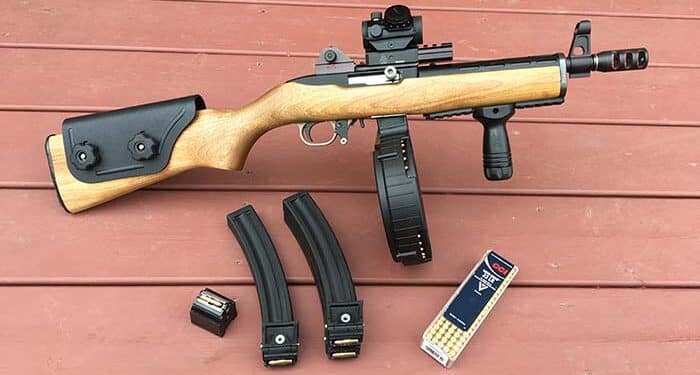By J.M. Ramos
In the past few years, the resurgence of interest in takedown style 10/22 rifles was at its peak since Ruger introduced their long-awaited version in March 28, 2012. It was not Ruger who first came up with the idea of converting their best-selling .22 carbine to a takedown style gun; it was Ram-Line who first mass-produced in limited quantity a takedown kit back in the 1980s, about the same time their classic aerospace polymer folding stock hit the market.
The big difference between the vintage Ram-Line kit and the Ruger version is in the overall set-up. The Ram-Line takedown kit consisted of their folding stock and 16-inch Ultralight polymer-lined steel-lined barrel (the very first of its kind that became an inspiration to many ultra-light, steel-lined bull barrels we see in the market today). Completing this set-up was a replacement oversized polymer barrel “V” block with thumb-operated retaining screws and a large knurled thumb-operated takedown screw that would allow a no-tool assembly and disassembly of the action from the stock. When fully assembled, the complete gun is very light and can be fired quite easily like a pistol with one hand, with a 50-round double stack magazine, another Ram-Line innovation. Complementing the Ram-Line takedown kit was a light gym style bag with multiple internal pockets to accommodate the action, barrel, the V block unit and spare magazines. This vintage takedown kit was created by Ram-Line basically to compete with the then very popular Charter Arm’s AR-7 Explorer survival carbine utilizing the same basic multi-sub component assembly and disassembly procedure but with a different approach on the in-storage system.
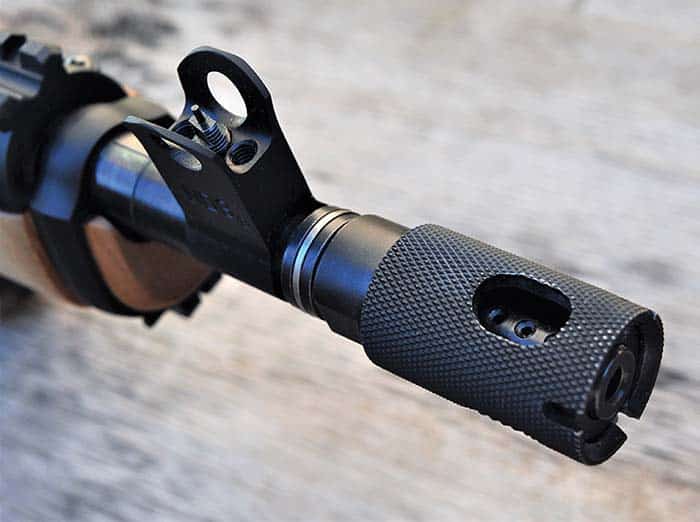
Ruger, on the other hand, took the procedure one step further and truly revolutionized it by developing a quick detach barrel system mated to the separate forearm allowing a two-piece sub group for a more compact storage during transport. While the factory takedown model accomplished its main purpose in normal scenarios where the user has time to take it out from its case or storage and was able to snap the two halves together to deal with a situation, there may also be a time when seconds mean life or death wherein a fully assembled gun takes the edge. Naturally, a fixed stocked 10/22 is not the answer when what is required is a very compact rifle that is easy to carry and store without the bulk and weight of a full-size rifle but still meets the legal overall minimum length of 26 inches. This specification is perfectly legal in Canada for a non-restricted .22 caliber firearm assuming the barrel is not cut down but a regular production barrel. Dlask Arms in Canada had at one time marketed a limited number of non-restricted short-barreled DAR-22 (their 10/22 clones) using Dlask 8-inch heavy barrels and custom Barracuda style laminated stocks. Although the handiness of the DAR SBR can be appreciated here, it proved to be bulky and heavy as a practical Mini-Scout rifle but not suited as an effective multi-function survival tool. In the US, this weapon size may fall under the short-barreled rifle (SBR) category and requires special license and fee from the BATF.
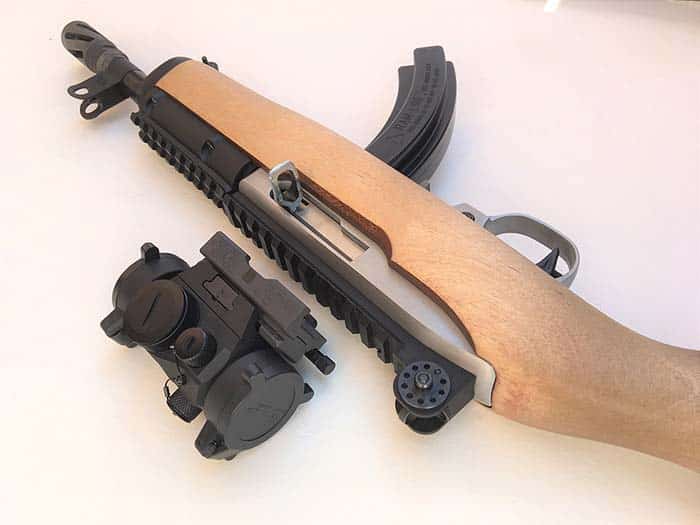
While a folding stock 10/22 with a light 16-inch barrel may fill the bill in most cases, it is still heavy and cumbersome, and the stock needs to be deployed in order to make a quick accurate shot placement. A light ultra-compact 10/22 with a wooden fixed stock and a good set of iron sights with optional rail for mounting optic is the perfect candidate for this requirement. The overall design features of the MSG are the culmination of a classy vintage scout rifle but with the advantages of a modern tactical arm in its simplest form. It’s attractive, very compact, user friendly and effective for the role it is designed for. The perfect harmony of wood and steel in the classic tradition makes this gun truly adorable to handle and to shoot and less offensive to those who despise the so-called evil black guns and their derivatives. This is where the 10/22 takedown challenger project takes its inspiration not only as an experimental interlude for the advance tinkerer but rather as an evolutionary offspring for future 10/22 siblings in its purest form.
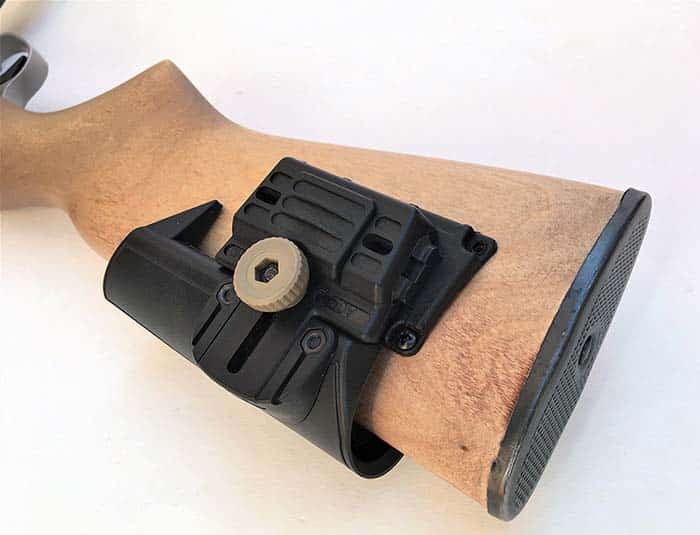
Creating the MSG required a bit of work most particularly with the factory wooden stock. Both the forearm and the buttstock required shortening and streamlining to trim as much weight as possible while improving its ergonomics in a slim-line format. To give the remodeled gun a nice touch, the original plastic butt plate was replaced with a surplus M1 .30 Carbine part. The 10/22 barrel band was retained to maintain the integrity of the assembly of the original design. To further complement its military-style heritage and to protect the operator from the exposed hot barrel above the forearm, the polymer MFT AK-47 upper handguard was utilized. The bottom section of this part was trimmed down to lower the height to line its top rail with the rail of the NDS-26 rear sight. The handguard is secured into position by a standard black #8X1 trim screw available from hardware stores. The NDS railed rear sight with matching front sight offers the best sight picture for the 10/22 and was the ideal choice here with the additional advantage of being able to accommodate varieties of red dots and rifle scopes. The NDS rear sight is mounted over the receiver making it higher than the factory sight. While the standard factory stock cheek rest is compatible when using the NDS iron sight, some higher mounted optics may no longer offer a comfortable aiming position. The CAA adjustable cheek piece is found to be the right accessory here; it is light, well-made, simple to adjust and easy to install, requiring only four small self-threading screws to mount it at the right side of the buttstock. The CAA adjustable cheekpiece and MFT AK-47 upper handguard complements the wooden stock perfectly keeping the overall format quite attractive, handy and streamlined.
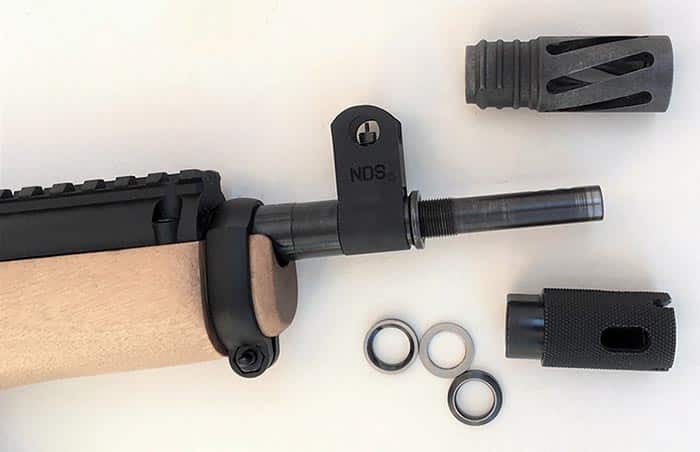
Used in this set-up is the Dlask SR-22, 12.5 inches trimmed to the factory’s original standard barrel specs to fit the barrel channel in the stock and to further shave more weight from the semi-tapered 0.750 O.D. barrel to keep the gun as light as possible. The front end was turned to 0.610-0.611 O.D. to fit the matching rear sight (NDS-44). The Dlask barrel comes complete with 1/2 X 28 TPI to take any AR-15 muzzle devices which makes this set-up even more versatile especially when using hot, high-velocity ammunitions for defensive application in combination with ultra-high-capacity magazines such as the Black Dog 50-round and GSG 110-round drum magazines. To keep the minimum overall legal length of the gun to 26 inches measured from the end of the butt to the tip of the barrel (not muzzle device), complete with a muzzle device such as the DoubleStar adjustable comp and the NEAG flash hider with helical slots, three small funnel shape vent holes were drilled perfectly in line with the DS and NEAG slot at the top of the barrel pass the threaded section. This arrangement not only proved practical but very effective in muzzle control compensating its lightened barrel, producing excellent groups averaging 1 to 1 ½-inch groups at 50 and 75 yards with hot CCI HV .22 rounds to include Mini Mags, Stingers and Velocitors. Overall, the custom Mini-Scout Gun proved every bit a remarkable companion that can be effectively employed as a life saver with the right ammunition and accessories, be it in urban or wilderness environments.
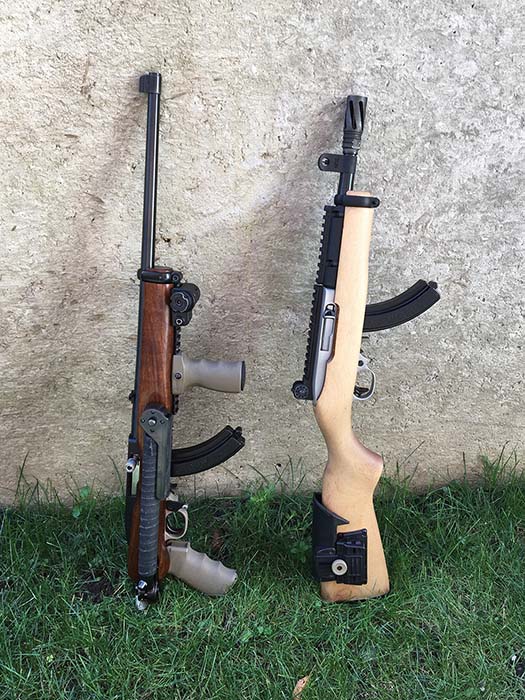
SOURCES
www.ruger-firearms.com
www.dlaskarms.com
www.nodakspud.com
www.missionfirsttactical.com
www.doublestarcorp.com
www.northeasternarms.com
www.armsmounts.com
www.hi-luxoptics.com
| This article first appeared in Small Arms Review V22N5 (May 2018) |



